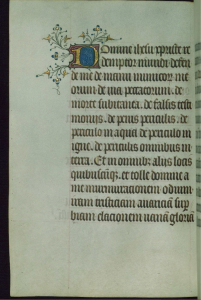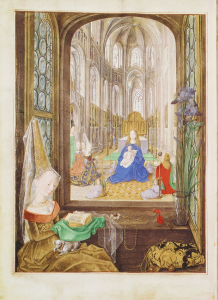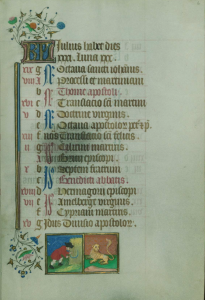Books of Hours were used daily for religious devotions and prayers by lay men and women. These books held immense sentimental importance, as seen through their status as heirlooms as they were passed from generation to generation in several families. To accentuate this sentimentality, many Books of Hours also featured several aspects of personalization that the owner of the book applied to make their Book of Hours more fitting and special for them. Amongst these personalization details, we most often see altered texts and headings, special decorations and self-insertion in miniatures.
To see exactly what I mean, we’ll refer to the Walters Book of Hours. (Baltimore, Walters Art Musuem, MS W.197.) [1] for examples.
This Book of Hours is of French origin, as can be noted by the choice of decoration as well as French headings throughout the text. The binding of this book features several fleur-de-lis figurations and is said to have likely been from Bruges or Ghent origin, thus explaining the utilization of French text as well as Latin, in order to convey the vernacular of the owner. The special binding of the Book of Hours is significant in that it was different for each book – always a reflection of the setting in which the book was bound.
The status of the owner can be exhibited in several ways as well – the higher the status, the more noticeable the personalization often is. The volume of extraordinary décor throughout the book, for example, is often a reflection of how wealthy the owner is. It was also not uncommon for the owner to toy with the power of ownership by toying with headings in the book as well as the text itself in order to better reflect their needs for devotion. In fact, the owner of the Walters book of hours chose to alter and add text in their vernacular, rather than Latin, to best reflect their heritage and personal preference. The owner’s French heritage is reflected in the three French prayers that are included in the litany that are not featured in any other books of hours on record.
“Domine ihesu Christe” (loosely translated to I beseech thee Jesus Christ) [2] are the first words seen on fol. 215v. Though this prayer is a commonality between most Books of Hours, the owner of the Walters book decided to incorporate their personal preferences into the prayer by at least changing the beginning of the prayer from “libera animas omnium fidelium defunctorum” (deliver the souls of all the faithful departed) to “redemptor mundi defende me de manu inunico meorum de ma peccatorum” (redeemer of the world, defend me from the hand of my sins). The owner purposefully chose to alter the words of this communion prayer in order to better serve his/her devotional needs. The prefatory rubric, found on fol. 215r, explains that consecutive recitation of this poem for thirty days will guarantee a change from tribulation into joy through the mercy of Christ [1].

Another way that owners of these books were able to make them their own was through their literal incorporation of themselves into the miniatures that are found in these books. Though we do not see this happening in the Walters Book of Hours, an excellent example of this can be found in the Hours of Mary of Burgundy. One specific miniature from this book comes to mind when discussing this idea of self-insertion.

In this miniature, we see Mary of Burgundy drawn into the miniature as if she is a vital role. As we see her reading her Book of Hours in the foreground, we also see her in the background picture as being in the presence of the Virgin Mary. This self-praising inclusion was utilized in hopes of equating one’s self to the holy figures featured in these miniatures and accompanying prayers. Commissioning a special artist to have yourself included in the miniatures was a rather common practice that was enjoyed only by those wealthy enough to afford it. Read more about that here. [3].
Another big aspect of personalization took place within the Calendar section of the Book of Hours. Each Calendar was responsible for outlining the dates in which a feast for specific Saints would be celebrated. This section of a Book of Hours was subjected to the origin in which the Book of Hours originated – meaning that if the book was created in France, there were more French Saints than not listed in the Calendar, as compared to if the book had been created in Belgium instead. This could be considered a form of personalization, just as the owner’s written-in details for certain dates of the calendars individualized the books accordingly. Just as we use calendars today, this area of a Book of Hours was used to record birthday and important holidays or occasions that the family deemed as important enough to be remembered.
The image below, for example, lists off copious saints and their respective feast days in honor of them. Amongst these saints is Belgium Saint Amalberga of Maubeuge, whose feast day is on July 10th [4]. This saint is said to be from Belgium, another signifier that could be argued as an aspect of personalization, considering that the book was probably produced in Belgium. The place of production of the book had a significant influence on the contents – thus personalizing each hand-made book accordingly.

Choosing the font, wallpaper and ringtone on our iPhone is probably the closest link we have to the volume of personalization that was enjoyed with these Books of Hours. Though each book consisted of the same general things – just as each iPhone comes with the same standard apps – there was much that could be added, altered, and beautified to the owner’s liking. Adding a prayer to the devotional section may equate to selecting different ringtones when specific apps notify you. A study has been done that concluded the average American spends 4.7 hours looking at their cell phone screen per day [5]. As staggering as that may be, what’s even more significant is that the lay men and women from centuries ago spent even more time per day referring to their Books of Hours, thus making it understandable as to why they wanted to add some details to make it their own. Just as many of our wallpapers feature us with friends or loved ones, their favorite miniatures may have featured them with the Virgin Mary and Christ Child. Though these alterations to our most-used items are drastically different now than they were, this action of personalization is still the same. It’s as though despite everything else in our world changing, our desire for self-inclusion and personalization has remained fundamental and important to each of us.
[1] – http://www.thedigitalwalters.org/Data/WaltersManuscripts/html/W197/description.ht
[2] – http://www.stjoesrichmond.org/prayers.html#Obsecro Te, Dulcissime Domine Iesu Christe
[5] – http://www.digitaltrends.com/mobile/informate-report-social-media-smartphone-use/
